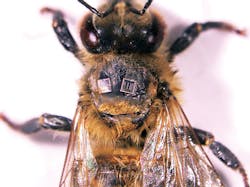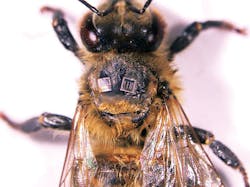Radio-frequency identification (RFID) tags for tracking the activity of honeybees in the hive revealed that about 20% of the foraging bees brought home more than half of the nectar and pollen gathered to feed the hive. When these overachievers are removed, though, the less active foragers improved their output by a factor of five within 24 hours to make up the difference.
Scientists at the University of Illinois Institute for Genomic Biology tagged the bees with laser-light-activated “p-Chip” PharmaSeq microtransponders, or tags. PharmaSeq laser readers connected via a USB cable to a computer detected the tags. Each tag carried a unique identification number. When lit by a reader’s red laser beam, photocells on each tag’s upper surface activate the chip to transmit its identification for a distance of up to 10 mm to a pickup coil in the head of the reader. PharmaSeq firmware and p-Chip Reader software process and decode the identification.
Due to the laser beam’s 1.5-mm diameter, researchers could attach two tags to each bee to increase the likelihood of detection (see the figure). Each tag measures 500 by 500 by 100 µm and weighs 90 µg. Two tags fit easily on each bee’s thorax and weigh just 56% of the average load carried by a nectar forager. The researchers believe, then, that the tags did not impair the natural foraging behavior. At a cost of $1.35 per tag, the researchers considered the tags disposable and eschewed retrieving them from the bees.
To read the tagged bees, a 10- by 10-mm plastic tube walkway was attached to the hive entrance. Two laser readers were projected into the top of the tube. Bees passed sequentially under each reader as they entered and exited the hive. The order of detection by each reader was used to infer the direction of travel. After detecting a bee, the reader passed the detected ID and reader number to a connected PC, which issued a time stamp.
“It is still possible that there truly are elite bees that have some differential abilities to work harder than others, but it’s a larger group than first estimated,” said Institute for Genomic Biology director Gene E. Robinson. “Or it could be that all bees are capable of working at this level and there’s some kind of colony-level regulation that has some of them working really, really hard, making many trips while others make fewer trips.”

